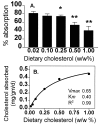Biliary cholesterol excretion: a novel mechanism that regulates dietary cholesterol absorption
- PMID: 9707623
- PMCID: PMC21484
- DOI: 10.1073/pnas.95.17.10194
Biliary cholesterol excretion: a novel mechanism that regulates dietary cholesterol absorption
Abstract
The regulation of dietary cholesterol absorption was examined in C57BL/6 and transgenic mice with liver overexpression of the scavenger receptor BI (SR-BI Tg). In C57BL/6 animals, feeding 0.02 to 1% (wt/wt) dietary cholesterol resulted in a dose-dependent decrease in the percentage of dietary cholesterol absorbed. A plot of total daily mass of dietary cholesterol absorbed versus the percentage by weight of cholesterol in the diet yielded a curve suggesting a saturable process with a Km of 0.4% (wt/wt) and a Vmax of 0.65 mg cholesterol/g body weight per day. Dietary cholesterol suppressed hepatic 3-hydroxy-3-methylglutaryl CoA reductase activity, stimulated cholesterol 7alpha-hydroxylase activity, and enhanced fecal excretion of bile acids, but none of these changes correlated with the percentage of dietary cholesterol absorption. Dietary cholesterol also caused an increase in biliary cholesterol concentration, and in this case the concentration of biliary cholesterol was strongly and inversely correlated with the percentage dietary cholesterol absorption (r = -0.63, P < 0.0001). Biliary cholesterol concentration was also directly correlated with daily cholesterol intake, dietary cholesterol mass absorption, and liver cholesterol ester content. Transgene-induced overexpression of SR-BI resulted in a stimulation of excretion of cholesterol into the bile and suppressed percentage dietary cholesterol absorption. Furthermore, biliary cholesterol levels in SR-BI Tg mice were strongly and inversely correlated with the percentage of dietary cholesterol absorbed (r = -0.99, P < 0.0008). In summary, these results suggest that the excretion of cholesterol into the bile plays an important role in regulating the percentage absorption of dietary cholesterol.
Figures





Similar articles
-
Down-regulation of intestinal scavenger receptor class B, type I (SR-BI) expression in rodents under conditions of deficient bile delivery to the intestine.Biochem J. 2001 Jun 1;356(Pt 2):317-25. doi: 10.1042/0264-6021:3560317. Biochem J. 2001. PMID: 11368757 Free PMC article.
-
Hepatic cholesterol and bile acid metabolism and intestinal cholesterol absorption in scavenger receptor class B type I-deficient mice.J Lipid Res. 2001 Feb;42(2):170-80. J Lipid Res. 2001. PMID: 11181745
-
The identification of intestinal scavenger receptor class B, type I (SR-BI) by expression cloning and its role in cholesterol absorption.Biochim Biophys Acta. 2002 Jan 30;1580(1):77-93. doi: 10.1016/s1388-1981(01)00190-1. Biochim Biophys Acta. 2002. PMID: 11923102
-
Scavenger receptor class B type I (SR-BI) and high-density lipoprotein metabolism: recent lessons from genetically manipulated mice.Int J Tissue React. 2000;22(2-3):29-37. Int J Tissue React. 2000. PMID: 10937352 Review.
-
The influence of some dietary factors on cholesterol metabolism.Proc Nutr Soc. 1975 Dec;34(3):271-8. doi: 10.1079/pns19750049. Proc Nutr Soc. 1975. PMID: 1108030 Review. No abstract available.
Cited by
-
The good side of cholesterol: a requirement for maintenance of intestinal integrity.J Lipid Res. 2017 Oct;58(10):1935-1936. doi: 10.1194/jlr.C079715. Epub 2017 Aug 2. J Lipid Res. 2017. PMID: 28768704 Free PMC article. No abstract available.
-
High Density Lipoprotein Reduces Blood Pressure and Protects Spontaneously Hypertensive Rats Against Myocardial Ischemia-Reperfusion Injury in an SR-BI Dependent Manner.Front Cardiovasc Med. 2022 Mar 21;9:825310. doi: 10.3389/fcvm.2022.825310. eCollection 2022. Front Cardiovasc Med. 2022. PMID: 35387446 Free PMC article.
-
Cholesterol-cholate-butterfat diet offers multi-organ dysfunction in rats.Lipids Health Dis. 2014 Dec 16;13:194. doi: 10.1186/1476-511X-13-194. Lipids Health Dis. 2014. PMID: 25515296 Free PMC article.
-
Influence of the high density lipoprotein receptor SR-BI on reproductive and cardiovascular pathophysiology.Proc Natl Acad Sci U S A. 1999 Aug 3;96(16):9322-7. doi: 10.1073/pnas.96.16.9322. Proc Natl Acad Sci U S A. 1999. PMID: 10430941 Free PMC article.
-
Decreased selective uptake of high density lipoprotein cholesteryl esters in apolipoprotein E knock-out mice.Proc Natl Acad Sci U S A. 1999 Oct 12;96(21):12050-5. doi: 10.1073/pnas.96.21.12050. Proc Natl Acad Sci U S A. 1999. PMID: 10518574 Free PMC article.
References
-
- Sonnenberg L M, Posner B M, Belanger A J, Cupples L A, D’Agostino R B. J Clin Epidemiol. 1992;45:413–418. - PubMed
-
- Panel on Detection, Evaluation, and Treatment of High Blood Cholesterol in Adults. J Am Med Assoc. 1993;269:3015–3023. - PubMed
-
- Zanni E E, Zannis V I, Blum C B, Herbert P N, Breslow J L. J Lipid Res. 1987;28:518–527. - PubMed
-
- Denke M A, Breslow J L. J Lipid Res. 1988;29:963–969. - PubMed
-
- Kolodgie F D, Katocs A S, Jr, Largis E E, Wrenn S M, Cornhill J F, Herderick E E, Lee S J, Virmani R. Arterioscler Thromb Vasc Biol. 1996;16:1454–1464. - PubMed
Publication types
MeSH terms
Substances
Grants and funding
LinkOut - more resources
Full Text Sources
Other Literature Sources
Medical
Research Materials
Miscellaneous

